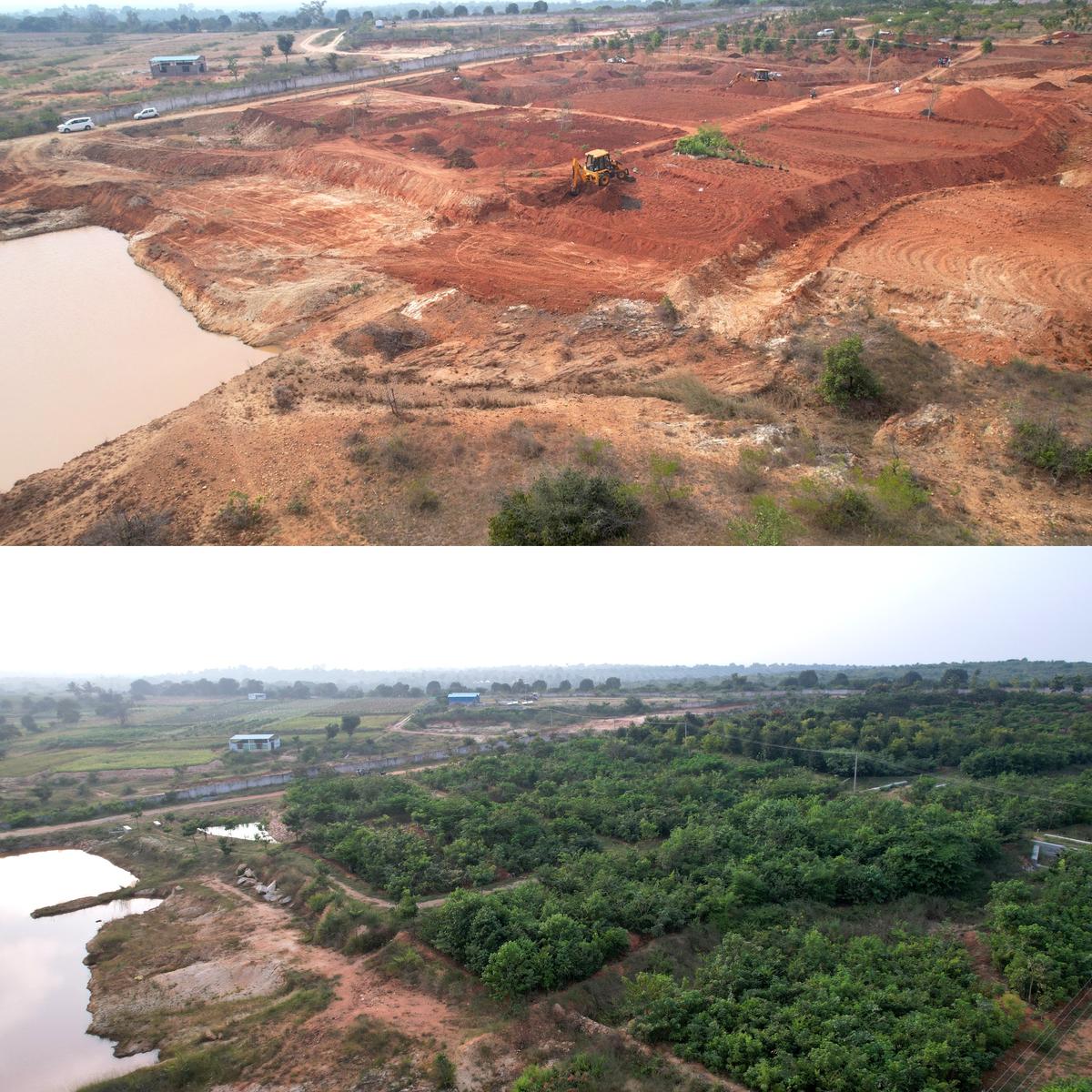A botanical park being developed by the Horticulture Department of Karnataka at Doddasaggere in Tumakuru district, modelled on the Lal Bagh in Bengaluru, has reportedly seen a significant rise in the number of species.
Before and after pictures of the region where the botanical park is being developed in Tumakuru district of Karnataka.
| Photo Credit:
Special Arrangement
As per an Avifauna Survey conducted at the Doddasaggere Botanical Garden, 75 bird species were recorded in March 2025, a significant rise from 35 in 2021. The documented birds include two near-threatened and one vulnerable species, along with five long-distance winter migrants.
Green cover
“The Doddasaggere Botanical Garden, planned to be developed on 228 acres, would be the second biggest botanical garden in Karnataka, the first being Lal Bagh in Bengaluru, and the third biggest in India,” said M. Jagadeesh, Joint Director of Horticulture (Parks & Gardens) at Lalbagh Botanical Garden.
Around 120 acres have been developed so far. In collaboration with IT services company Mphasis and non-profit United Way of Bengaluru, an afforestation drive was taken up on 14 acres within the garden, where 1,00,000 saplings of 77 native tree species were planted to recreate a dense dry deciduous forest.
The species sighted in Doddasaggere Botanical Garden include Pallid Harrier, Asian Woolly Neck, River Tern, Booted Warbler, Green Sandpiper, Lesser Whitethroat and Tawny pipit, among others.
| Photo Credit:
Special Arrangement
“When we started the work, it was a barren piece of land. Now, we have spotted nearly 80 types of birds, and close to 50 species of animals, reptiles, butterflies, and bees,” said Mr. Jagadeesh.
The species sighted include Pallid Harrier, Asian Woolly Neck, River Tern, Booted Warbler, Green Sandpiper, Lesser Whitethroat and Tawny Pipit, among others.
Carbon sequestration goals
Over time, the forest cover in the park is expected to sequester approximately 2,100 tonnes of carbon dioxide and release around 10,000 tonnes of oxygen annually.
“We looked at what the country’s pressing needs were, and carbon sequestration and oxygen generation were among the critical ones. We explored the projects that could help achieve these goals and reached out to a few partners, including United Way. The afforestation drive in Doddasagare Park is one such initiative,” said Deepa Nagaraj, Head of ESG and CSR at Mphasis.
Rajesh Krishnan, CEO at United Way of Bengaluru, added that the afforestation will also help recharge groundwater, prevent soil erosion and improve soil fertility.
“It will support the preservation of 47 native tree species, and provide food and shelter for over 75 species of birds, 14 species of butterflies, 11 species of reptiles and 11 species of amphibians,” he said.
Emphasis on soil and water conservation
The park comprises 17 blocks, including a bird block, a fragrance block, a palmetum and a nutrition garden with nearly 400 types of fruiting plants. According to Mr. Jagadeesh, emphasis was laid on soil and water conservation, given the low rainfall Tumakuru receives.
Indian Cricket Frog spotted at Doddasaggere Botanical Park in Tumakuru district of Karnataka.
| Photo Credit:
Special Arrangement
“We are constructing checkpoints, water tanks and mini dams inside the park. Already, we have constructed three very big ponds and several check bunds. In addition to that, we have four borewells. The water yield is very good. We irrigate all the existing planted trees through drip irrigation and use mulching technique to conserve water,” he said.
Published – September 23, 2025 01:06 pm IST




Comments are closed.